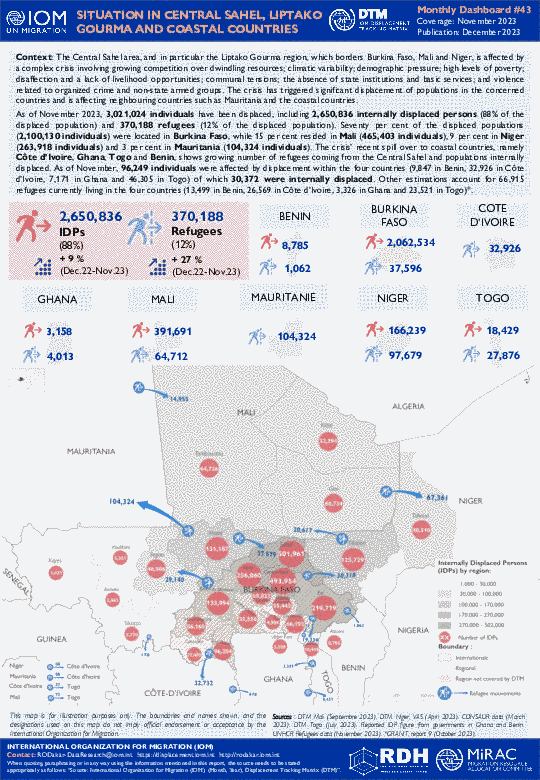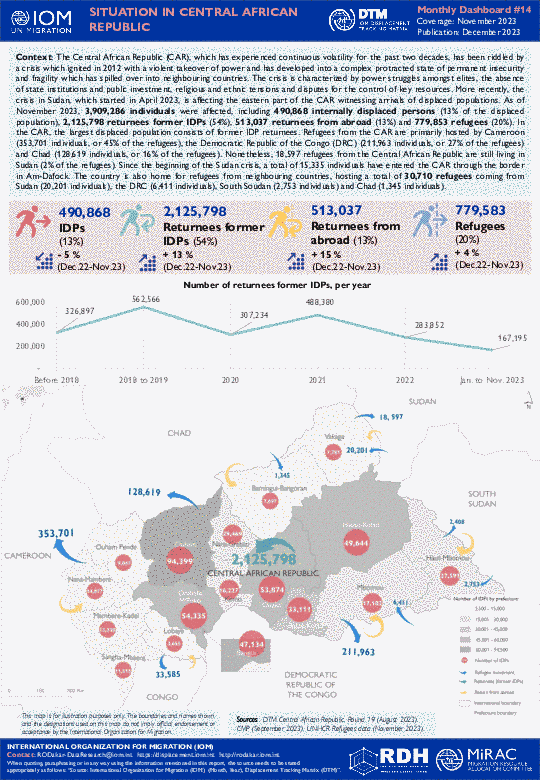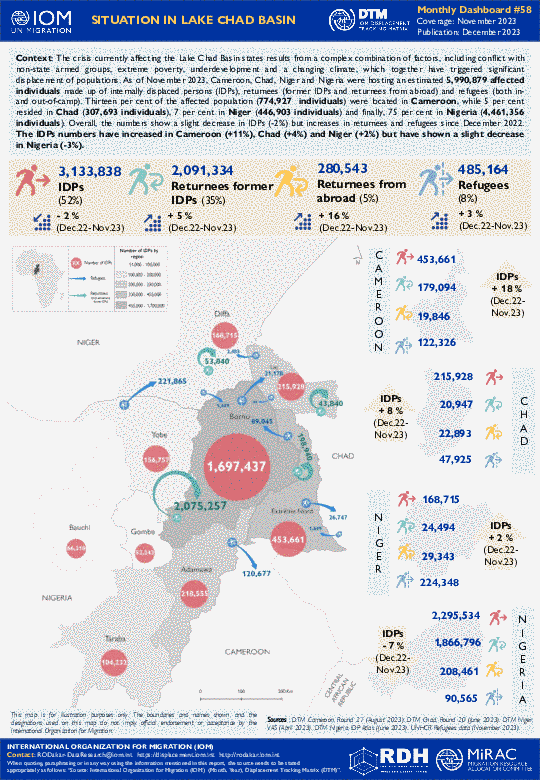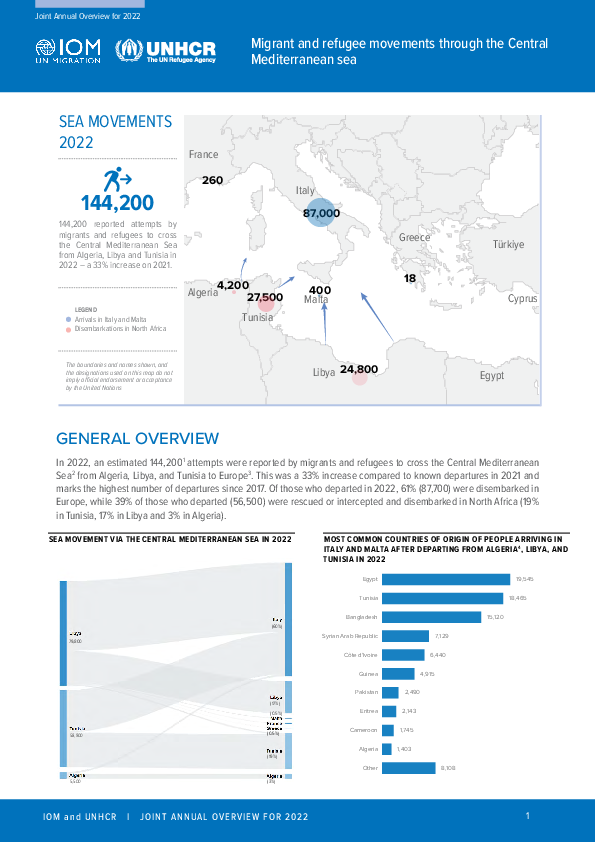-
Countries
-
Data and Analysis
-
Special Focus
-
Crisis Responses
Compilation/Overview
Color
white

Contact
DTM Zimbabwe, DTMzimbabwe@iom.int, DTMsupport@iom.int
Language
English
Location
Zimbabwe
Period Covered
Oct 01 2023
Oct 31 2023
Activity
- Flow Monitoring
During the month of October 2023, a total of 58,550 movements were recorded and 3,415 migrants were interviewed across 38 Flow Monitoring Points (FMPs) in Zimbabwe. The total movements recorded increased by 19% compared to the previous month. Sixty-eight per cent of movements observed were inflows, whilst 32% were outflows. The top three sending districts were Beitbridge (45%), Harare (14%) and Chiredzi (8%), whilst the top three receiving districts were Harare (32%), Beitbridge (13%) and Bulawayo (11%). Matabeleland South province recorded the highest number of outflows (50%) whilst Harare province recorded the highest number of inflows (32%).
The South Africa-Zimbabwe corridor recorded the highest movement of 46,668 (80%) followed by the Zambia-Zimbabwe corridor which recorded 7,534 (13%) movements. Fifty-seven per cent of movements along the South Africa-Zimbabwe corridor were short-term movements, 20% were for family reunification whilst 19% were long-term economic movements. Of the migrants travelling from South Africa, 27% were going to Harare, 11% to Beitbridge and 8% to Bulawayo.
The Zambia-Zimbabwe corridor consisted of 56% short-term movements, 23% family reunification movements and 21% long-term movements. Of the migrants travelling from Zambia, 56% were travelling to Harare, 18% to Hurungwe and 12% to Bulawayo.
Migrants travelling from Matabeleland South highlighted Limpopo, South Africa (70%), and Gauteng, South Africa (20%) as their intended destination. Those travelling to Botswana indicated Central Province (3%) as their
intended destination. Of the incoming migrants travelling to Harare, 34% were travelling from Gauteng (South Africa), 31% from Lusaka (Zambia), and 11% from Limpopo (South Africa).
The Central Sahel area, and in particular the Liptako Gourma region, which borders Burkina Faso, Mali and Niger, is affected by a complex crisis involving growing competition over dwindling resources; climatic variability; demographic pressure; high levels of poverty; disaffection and a lack of livelihood opportunities; communal tensions; the absence of state institutions and basic services; and violence related to organized crime and non-state armed groups. The crisis has triggered significant displacement of populations in the concerned countries and is affecting neighbouring countries such as Mauritania and the coastal countries.
As of November 2023, 3,021,024 individuals have been displaced, including 2,650,836 internally displaced persons (88% of the displaced population) and 370,188 refugees (12% of the displaced population). Seventy per cent of the displaced populations (2,100,130 individuals) were located in Burkina Faso, while 15 per cent resided in Mali (465,403 individuals), 9 per cent in Niger (263,918 individuals) and 3 per cent in Mauritania (104,324 individuals). The crisis’ recent spill over to coastal countries, namely Côte d’Ivoire, Ghana, Togo and Benin, shows growing number of refugees coming from the Central Sahel and populations internally displaced. As of November, 96,249 individuals were affected by displacement within the four countries (9,847 in Benin, 32,926 in Côte d’Ivoire, 7,171 in Ghana and 46,305 in Togo) of which 30,372 were internally displaced.
The Central African Republic (CAR), which has experienced continuous volatility for the past two decades, has been riddled by a crisis which ignited in 2012 with a violent takeover of power and has developed into a complex protracted state of permanent insecurity and fragility which has spilled over into neighbouring countries. The crisis is characterized by power struggles amongst elites, the absence of state institutions and public investment, religious and ethnic tensions and disputes for the control of key resources. More recently, the crisis in Sudan, which started in April 2023, is affecting the eastern part of the CAR witnessing arrivals of displaced populations.
As of November 2023, 3,909,286 individuals were affected, including 490,868 internally displaced persons (13% of the displaced population), 2,125,798 returnees former IDPs (54%), 513,037 returnees from abroad (13%) and 779,853 refugees (20%). In the CAR, the largest displaced population consists of former IDP returnees. Refugees from the CAR are primarily hosted by Cameroon (353,701 individuals, or 45% of the refugees), the Democratic Republic of the Congo (DRC) (211,963 individuals, or 27% of the refugees) and Chad (128,619 individuals, or 16% of the refugees). Nonetheless, 18,597 refugees from the Central African Republic are still living in Sudan (2% of the refugees). Since the beginning of the Sudan crisis, a total of 15,335 individuals have entered the CAR through the border in Am-Dafock. The country is also home for refugees from neighbouring countries, hosting a total of 30,710 refugees coming from Sudan (20,201 individuals), the DRC (6,411 individuals), South Soudan (2,753 individuals) and Chad (1,345 individuals).
In Central America, North America and the Caribbean, large migratory movements emerge and flow. According to migration data from the government of Panama, between July and December 2022, at least 198,832 migrants entered Panama through the Darien route. During the same period in 2021, 107,510 people entered, representing an 85 per cent increase.
From July to December 2022, IOM's Displacement Tracking Matrix (DTM) collected primary data in more than 40 locations in the Region. DTM is a system to collect and analyze primary data, to disseminate critical information on the mobility, vulnerabilities and needs of displaced and mobile populations, for decision making and to provide context-specific assistance. Between July and December 2022, DTM activities were carried out by eight countries in the region, through the implementation of different DTM components including mobility tracking of IDPs, flow monitoring registry and surveys, as well as surveys to people on the move and returnees.
This report aims to provide an overview of migration movements in the region, including the locations and months in which primary data were collected through DTM instruments.
The crisis currently affecting the Lake Chad Basin states results from a complex combination of factors, including conflict with non-state armed groups, extreme poverty, underdevelopment and a changing climate, which together have triggered significant displacement of populations. As of November 2023, Cameroon, Chad, Niger and Nigeria were hosting an estimated 5,990,879 affected individuals made up of internally displaced persons (IDPs), returnees (former IDPs and returnees from abroad) and refugees (both in-and out-of-camp).
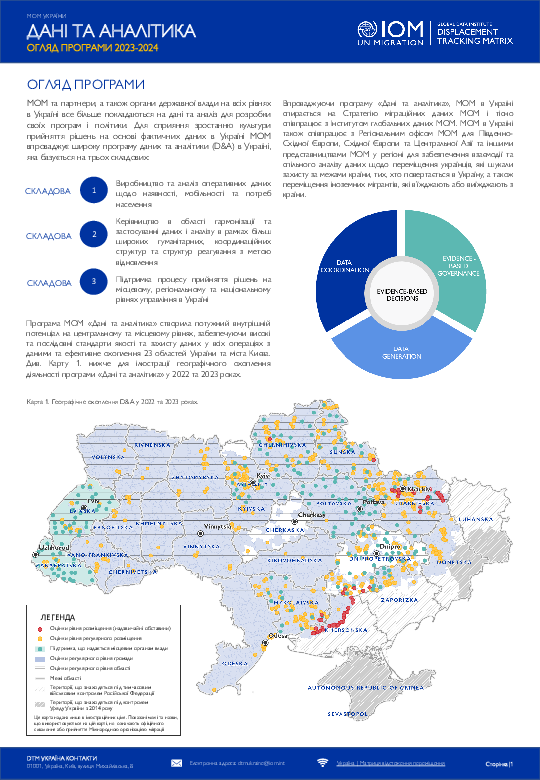
Contact
NMS Ukraine, nmsukraine@iom.int
Language
English
Location
Ukraine
Period Covered
Jan 01 2023
Dec 31 2024
Activity
- Other
Щоб сприяти зростанню культури прийняття рішень на основі фактичних даних в рамках реагування на надзвичайні ситуації в Україні, МОМ впроваджує в Україні широку програму "Дані та аналітика" (D&A), яка ґрунтується на трьох основних компонентах: Генерація даних, Координація даних та Управління на основі фактичних даних. В Огляді програми "Дані та аналітика" представлено обсяг і спрямованість програми МОМ в Україні в галузі даних та аналітики на період 2023-2024 років. У ньому детально описуються оцінки, проведені Аналітичним відділом, поточні зусилля, що докладаються за кожним напрямом, а також ключові досягнення Аналітичного відділу, спрямовані на підтримку збору, аналізу, розповсюдження та використання надійної доказової бази для прийняття стратегічних та оперативних рішень у контексті гуманітарного реагування в Україні.
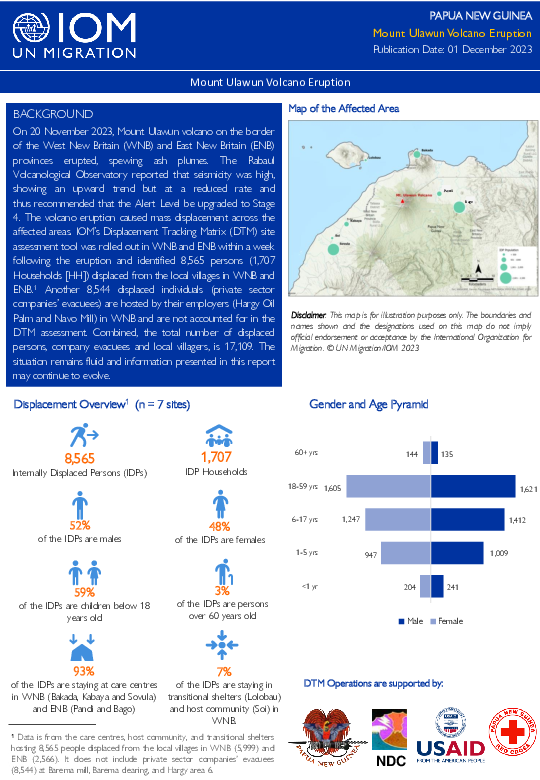
Contact
DTM Papua New Guinea, iompngmdac@iom.int
Language
English
Location
Papua New Guinea
Period Covered
Nov 22 2023
Nov 30 2023
Activity
- Mobility Tracking
- Site Assessment
- Baseline Assessment
On 20 November 2023, Mount Ulawun volcano on the border of the West New Britain (WNB) and East New Britain (ENB) provinces erupted, spewing ash plumes. The Rabaul Volcanological Observatory reported that seismicity was high, showing an upward trend but at a reduced rate and thus recommended that the Alert Level be upgraded to Stage 4. The volcano eruption caused mass displacement across the affected areas. IOM’s Displacement Tracking Matrix (DTM) site assessment tool was rolled out in WNB and ENB within a week following the eruption and identified 8,565 persons (1,707 Households [HH]) displaced from the local villages in WNB and ENB.1 Another 8,544 displaced individuals (private sector companies’ evacuees) are hosted by their employers (Hargy Oil Palm and Navo Mill) in WNB and are not accounted for in the DTM assessment. Combined, the total number of displaced persons, company evacuees and local villagers, is 17,109. The situation remains fluid and information presented in this report may continue to evolve.
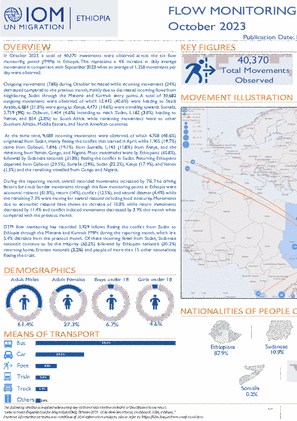
Contact
DTM Ethiopia, DTMEthiopia@iom.int
Language
English
Location
Ethiopia
Period Covered
Oct 01 2023
Oct 31 2023
Activity
- Flow Monitoring
In October 2023, a total of 40,370 movements were observed across the six flow monitoring points (FMPs) in Ethiopia. This represents a 4% increase in daily average movements in comparison with September 2023 when an average of 1,258 movements per day were observed.
Outgoing movements (76%) during October increased while incoming movements (24%) decreased compared to the previous month, mainly due to decreased incoming flows from neighboring Sudan through the Metema and Kurmuk entry points. A total of 30,682 outgoing movements were observed, of which 12,442 (40.6%) were heading to Saudi Arabia, 6,684 (21.8%) were going to Kenya, 4,473 (14.6%) were travelling towards Somalia, 2,759 (9%) to Djibouti, 1,404 (4.6%) intending to reach Sudan, 1,162 (3.8%) heading to Yemen, and 854 (2.8%) to South Africa, while remaining movements were to other Southern African, Middle Eastern, and North American countries.
At the same time, 9,688 incoming movements were observed, of which 4,708 (48.6%) originated from Sudan, mainly fleeing the conflict that started in April, while 1,905 (19.7%) came from Djibouti, 1,846 (19.1%) from Somalia, 1,143 (11.8%) from Kenya, and the remaining from Yemen, Congo, and Nigeria.
UNHCR and IOM Joint Annual Overview 2022
In 2022, an estimated 144,200 attempts were reported by migrants and refugees to cross the Central Mediterranean Sea from Algeria, Libya, and Tunisia to Europe3. This was a 33% increase compared to known departures in 2021 and marks the highest number of departures since 2017. Of those who departed in 2022, 61% (87,700) were disembarked in Europe, while 39% of those who departed (56,500) were rescued or intercepted and disembarked in North Africa (19% in Tunisia, 17% in Libya and 3% in Algeria).
In 2022, more than 2,4005 migrants and refugees are known to have lost their lives or gone missing at sea while attempting to cross to Europe along the three Mediterranean routes (Eastern, Central and Western Mediterranean), an increase of 17% compared to some 2,050 deaths recorded in 2021. Most of those deaths in 2022 (59%) took place on the Central Mediterranean Route.

Contact
DTM Ukraine, DTMUkraine@iom.int
Language
English
Location
Ukraine
Period Covered
Jan 01 2023
Dec 31 2024
Activity
- Other
To foster the growing culture of evidence-based decision-making across the Ukraine response, IOM implements a broad Data and Analytics (D&A) programme in Ukraine, based on three pillars: Data Generation, Data Coordination, and Evidence-Based Governance. The Data and Analytics Programme Overview presents the scope and focus of IOM Ukraine’s Data and Analytics programme for the period 2023-2024. It details the assessments conducted by D&A, describes the ongoing efforts undergone by each Pillar, and shares the key achievements reached by D&A to support the collection, analysis, dissemination and use of a strong evidence base in strategic and operational decision-making in the context of the Ukraine humanitarian response.
Pagination
- Previous page
- Page 15
- Next page
